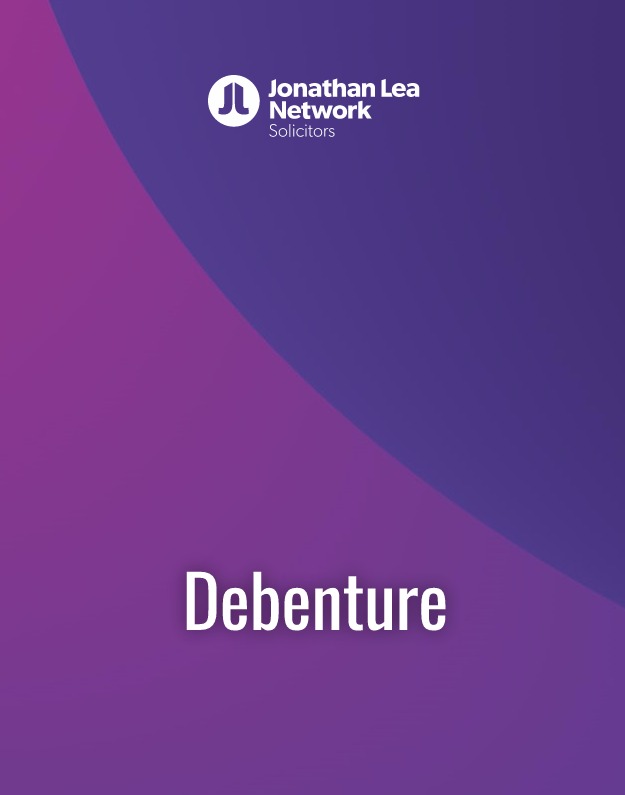Debenture
£6.99
This template debenture is suitable where a creditor is to take a form of security over the assets of a debtor that is a limited company as security. This provides protection to the creditor if the debtor were to default. You are of course free to adapt the template debenture as you deem necessary.
Whilst we make every effort to ensure the materials provided on this website are accurate and up to date, we do not warrant, whether express or implied that the template articles and guidance will be free of any inaccuracies, omissions or errors (“Faults”). We shall not be liable for any loss, damage or cost resulting from any such Faults. You assume sole responsibility and entire risk as to the suitability and results obtained from use of the template articles and guidance.
Using This Template
This template debenture is suitable where a creditor is to take a form of security over the assets of a debtor that is a limited company as security. This provides protection to the creditor if the debtor were to default. You are of course free to adapt the template debenture as you deem necessary.
Whilst we make every effort to ensure the materials provided on this website are accurate and up to date, we do not warrant, whether express or implied that the template articles and guidance will be free of any inaccuracies, omissions or errors (“Faults”). We shall not be liable for any loss, damage or cost resulting from any such Faults. You assume sole responsibility and entire risk as to the suitability and results obtained from use of the template articles and guidance.
Your input is required at the parts of the template highlighted in yellow and the wording inside the square brackets which we have included explains clearly the information that should be inserted. You are advised to fill in the wording in square brackets in lower case unless directed otherwise. Any figures should be entered in numerical form. The square brackets and any yellow highlight should be removed after the amendments are made (so as to produce a ‘final form’).
This debenture is intended as a template only and must be adapted to the particular circumstances of your case.
Clause 1 (Definitions & Interpretation)
Section 1 sets out the definitions that will apply throughout the Agreement – the main purpose behind this is to reduce repetition within the body of the agreement, making it shorter and easier to read.
In addition, as it gives specific meanings to particular terms used and avoids ambiguity and makes it clear that those terms are intended to include matters which they might otherwise be found not to cover (or vice versa).
Unless expressly defined, the courts will interpret non-technical terms in accordance with their ordinary and natural meaning, or the meaning which can be inferred by the words that the parties chose to use in the articles. Extrinsic expert evidence may be necessary to interpret technical terms not defined in the agreement itself.
In terms of the different classes of assets that are referred to as being charged, it does not matter if the company might not hold any of a particular type of asset yet – if it acquires some of it in the future, then it will be covered by this debenture template.
Clause 2 (Covenant to Pay)
This clause ensures that the Lender is able to enforce payment due to the inclusion of the words ‘on demand’. The clause allows the Lender to exercise its rights to enforce security.
Clause 2.2 asserts that interest will be payable if the Borrower fails to pay any amount. The interest rate is set to the Default Rate from to time.
Clause 3 (Charging Provisions)
This is the main clause in the document, under which the company grants a series of charges in favour of the creditor. Such security can take the form of fixed or floating charges, which are taken over the borrower’s assets by the lender. The former prevents the borrower from dealing with the charged asset, whereas the latter allows the asset to be dealt with. A fixed charge can be taken over the borrower’s property. Examples of property listed in Clause 3.1.1 include freehold/leasehold interests or estates, interests/licences in land, agreements related to fixtures/chattels and intellectual property rights. All remaining assets that are not already charged can be made subject to a floating charge.
Assignment of the borrower’s right, title and interest in and to any agreement has the effect of giving the lender control over the asset, unless being incapable of assignment as per Clause 3.3. The borrower must seek written consent from the lender if they wish to deal with the charged asset in the ways set out in Clause 3.6.
Fixed charges or mortgages rank in priority over the floating charges in the debenture, unless provided otherwise by the lender at the time the security was created. The lender can immediately convert a floating charge into a fixed charge over the assets listed in Clause 3.5, provided they give notice of this to the borrower.
The borrower is required to submit an application to the Chief Land Registrar to enter a restriction on the registered title to his current and future registered freehold and leasehold property. This ensures that no disposition, charge or other security interest can be registered in respect of the property without the signed written consent of the proprietor, namely the lender, or an authorised signatory.
Once the debenture is executed, the borrower must give the certificates and documents of title to stocks, shares, securities and stamped stock transfer forms to the lender. The borrower may then complete any remaining formalities for transfer of title after the creation of the debenture. Clause 3.9 also lists requirements to be provided in writing by the borrower to the lender, if reasonably requested and necessary for reasons such as protection of the security.
The borrower must collect and realise his book, debts and monies, which are to be held on trust for the lender, and pay money received as a result of the book, debts and monies to the lender. Paragraph 14 of Schedule B1 of the Insolvency Act 1986 also provides that the holder of the floating charge may appoint an administrator of the company.
Clause 4 (Continuing Security)
This is a standard clause which ensures that the security remains in force regardless of whether or not any or all of the sum owed by the debtor has been repaid. This prevents any argument that may be had as to whether the security should be released (e.g. if the debtor’s account is in credit).
Clause 5 (Undertakings)
This clause provides a list of undertakings (i.e. promises) given by the borrower in respect of the debenture. For example, that it keeps the assets insured and in good repair, and does not alter them significantly. This clause imposes restrictions on the company in dealing with the charged property. For example, it should not charge the property or rent it to someone else without permission.
Clause 6 (Security Protections)
A Lender will want to take steps to protect the security where the Borrower fails to do so. This clause therefore provides the Lender with the necessary powers to fix any such breach. For example, the Lender may take out insurance on an asset. It should also be noted that this clause prevents the Lender from parting with any of the charged properties without the consent of the Lender.
Any costs incurred as a result of these protections will be owed by the Borrower (usually with interest).
A further protection normally stipulated within a debenture agreement is the power granted to the Lender to appoint a receiver. This is detailed separately in Clause 8.
Clause 7 (Enforcement)
Clause 7.1 sets out when the security becomes enforceable – i.e. after a default of some sort. Clauses 7.2 and 7.3 include some extra protections and powers for the creditor and should not be deleted.
Clause 8 (Appointment of Receiver or Administrator)
After default by the company, the creditor will often enforce its security by appointing a “receiver”. The receiver has power to resolve matters, manage the assets and get them ready for sale. Clause 8.1 refers to the creditor’s power to appoint a receiver. Clause 8.5 sets out various standard powers the receiver will have.
Clause 9 (Power of Attorney)
As part of the security, the creditor will hold a “power of attorney” over the company. This will permit the creditor to sign documents or do various things on the company’s behalf. This might be needed, for example, if the creditor is enforcing the mortgage due to the company’s default. Usually, as a result, the company is not co-operating or responding to any communications from the creditor. This should reduce the creditor’s costs and reduce wasted time. Therefore the necessary charges for interest (for all of which the company is liable in any event) also reduce.
Clause 10 (Application of Security Proceeds)
This outlines the order in which any money recovered as a result of the enforcement of the security is applied.
It should be noted that the proceeds of an insurance payout are set out separately in Clause 6.2.
Clause 11 (Set-Off)
Set-off applies where both parties have a financial claim against the other. The effect is to allow the parties to deduct the costs of one claim from the other, leaving just the balance due.
The principal purpose of this clause is to grant the Lender the right to set-off any cross-claims that may arise without needing to pursue litigation and thereby incur extra costs.
The set-off rights for the Borrower may also be restricted in this clause if so desired. However, it should be noted that the parties cannot contract out of insolvency set-off.
Clause 12 (Notices)
This clause outlines the methods in which notice must be communicated by either party to the agreement.
Clause 13 (Miscellaneous)
This clause includes several standard provisions found in most other Debenture agreements.
Should any provision become illegal after signing, Clause 13.1 ensures the rest of the agreement is not rendered invalid as a result.
Clause 13.4 prevents third parties exercising any statutory rights with respect to the agreement’s terms.
Clause 14 (Release)
Although it cannot be contracted out of, this clause is included here to reinforce the Borrower’s right to request that any assets acting as security should be released upon the satisfaction of all debts (i.e. Secured Obligations).
Clause 15 (Governing Law and Jurisdiction)
A jurisdiction clause should be included to identify the forum in which parties would like disputes under the settlement agreement to be resolved. The draft provides for disputes to be resolved in the courts of England and Wales.
This sets out the governing law of any disputes or claims, alongside the method by which these would be resolved. We emphasise the use of arbitration as this ensures consistency of treatment. It also avoids any conflicts between documents.
A governing law clause should be included where the parties want all disputes arising under the agreement to be determined in accordance with the substantive laws of a particular country. The choice of governing law should be considered before beginning to draft since, if it is not to be English law, a lawyer qualified in the relevant jurisdiction will need to advise on, or draft, the agreement.
Clause 16 (Registration)
As the wording states, this clause simply places the onus of the Debenture’s registration upon the Borrower and acknowledges the Lender’s consent to do so.









